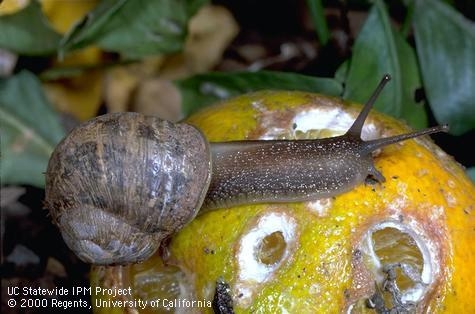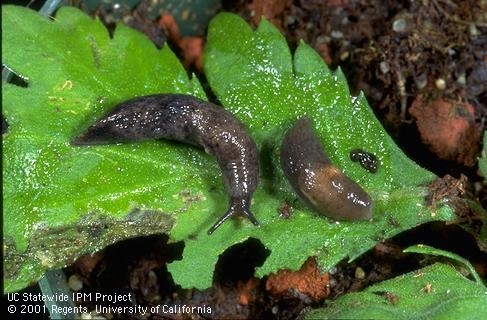Advice for the Home Gardener from the Help Desk of the
UC Master Gardener Program of Contra Costa County
Client: Help!!! I'm a relatively new vegetable gardener. I just planted my summer vegetable garden seedlings this week. Within the week I'm finding severely damaged zucchini seedlings with holes in the leaves and for some of them the entire seedling is gone. What is doing this? And what can I do to prevent such damage?
Control of these pests in the garden is usually a combination of methods. Hand picking at night with a flash light can be a quick and easy way to control the population. As you pick them off your plants or off the ground you can drop them into a container of mild soapy water. I personally like to wear garden gloves for this task. The water can be drained off in an out of the way spot in your yard and the snails and slugs disposed of in your trash bin.

The fourth possibility is birds. Pesky birds can do a lot of damage to your tender young plants. However, they are also your "friend" for all the garden pests they feed on as well as being protected by law. If birds are the "problem", to control the birds you will need to get some "bird netting" over your plants. Half-inch diameter PVC pipe works well for making an arch or tent over your plants. The method would be to drive 24" pieces of ¼ inch re-bar into the ground about 2 to 3 feet apart along BOTH sides of your plants (and opposite one another) far enough apart so that the PVC can be readily bent into an arch and slide over both of the opposite re-bars,. Stretch your bird netting over the arches and secure it in place with clips, string or twist-ties. You can also find some other methods of making these arches on YouTube videos at https://www.youtube.com/watch?v=vEn-XQ5nA4k
Free UC Guidance on Snail & slug Management in the garden
(includes videos on identification of pest, applying bait, etc.):
http://ipm.ucanr.edu/PMG/PESTNOTES/pn7427.html
Free UC Guidance on Earwig Management in the garden:
http://ipm.ucanr.edu/PMG/PESTNOTES/pn74102.html
I would do the nighttime check for snails and slugs first and try some of the trapping methods before I went to the trouble and expense of putting up bird netting. With a little effort I believe you can get the problem under control. However, the sad news is it looks to me like the zucchini plant will need to be pulled out and replanted as there does not seem to be enough leaf material left to sustain the plant. There is some good news here though, it's early in the growing season and the new zucchini will catch up in no time.
Help Desk of the UC Master Gardener Program of ContraCostaCountyf (BHD)
Note: The UC Master Gardeners Program of Contra Costa's Help Desk is available year-round to answer your gardening questions. Except for a few holidays, we're open every week, Monday through Thursday for walk-ins from 9:00 am to Noon at 75 Santa Barbara Road, 2d Floor, Pleasant Hill, CA 94523. We can also be reached via telephone: (925) 646-6586, email: ccmg@ucanr.edu, or on the web at http://ccmg.ucanr.edu/Ask_Us/ MGCC Blogs can be found at http://ccmg.ucanr.edu/HortCoCo/ You can also subscribe to the Blog (//ucanr.edu/blogs/CCMGBlog/).